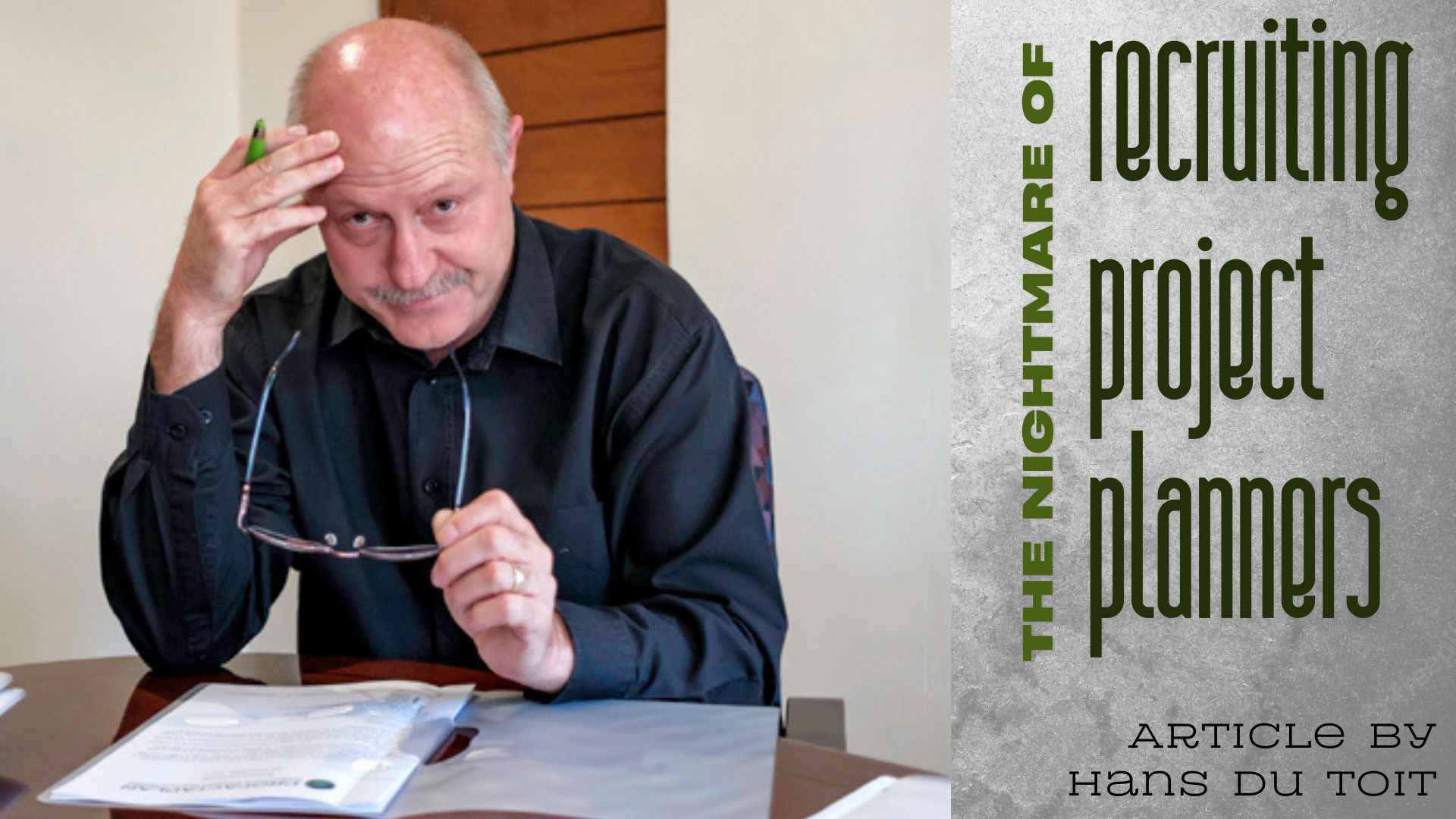
In this article:
- Recruitment nightmare in project planning.
- The recruitment process.
- Post appointment realization.
- Consequences of wrong appointments.
- An example of a recruitment nightmare
- Transforming process
- Conclusion
My Journey Through the Recruitment Nightmare in Project Planning:
I’ve been in the construction business for most of my working career of 38 years. Of this, I’ve been specialising in project planning and scheduling for more than 28 years and in project controls for the past 12 years. Having filled planning and project control management positions in various organisations, I had my fair share of what turned out to be recruitment nightmares!
The Recruitment Process: A seemingly simple task
The recruitment process would seem simple: create a job specification, have HR draft an advertisement and either advertise directly or involve the services of recruitment agencies. Whenever we approached agencies we were flooded with applicants, most of the time. The intent was that HR would shortlist candidates and pass onto me what they considered to be the best ones. However, since it is such a difficult environment to judge properly, I invariably ended up having to shortlist.
Shortlisting Candidates: The fist part of the recruitment nightmare
Shortlisting meant reading through each and every CV to identify similarities between our requirements and their offerings and selecting the best matched for interview. This was the first part of the nightmare. Despite all my other duties that still had to be performed, I now had to read through piles of CV’s to identify traits from each one. These piles could be anything from 10 to 15 and sometimes even more. This had to be transferred to an evaluation model in order to weigh candidates against each other. Because one tried to do it as fairly as possible, it was a difficult and time consuming exercise.
The Interview Process: The second part of the recruitment nightmare
Once we finally had the shortlist, we could schedule the interviews, bringing us to the second part of the nightmare.
Interviewing spanned days, depending on the number of shortlisted candidates. A large proportion of the interview time was spent on technical related questions aimed at determining the skill and capabilities of candidates. Only a small proportion of time and questions were aimed at identifying behaviours and personalities.
To try and cut down on interview times, sometimes out of the office, we attempted telephonic “pre-interviews”, but I feel this may have disqualified more suitable candidates since we could not really evaluate body language and expected behaviours.
There were also times that we did not make an appointment having gone through the process, forcing us to extend our search and thereby the number of interviews to a second round. Finally, an appointment would be made, which should be the end of the process, right? Wrong!
Post-Appointment Realizations: The third part of the recruitment nightmare
On several occasions it turned out that the incumbents that I had appointed simply did not live up to my expectations.
We found ourselves in situations where people could discuss and explain the terminology and concepts but were not always able to properly apply them, and we unfortunately came to that realization post appointment when incumbents had to deliver.
This third part of the nightmare must have been the most difficult. Some of the key outputs we expect from planners/schedulers are to be able to develop and maintain quality schedules. This is generally evaluated at the hand of some basic checks such as open-ended activities, durations being extended compared to the original estimates, critical path analysis for relevancy and so on.
In addition, given the environment that we find ourselves in nowadays, practitioners are expected to have a basic understanding of how to introduce discreet events resulting from client instructions or from self-imposed issues, into the schedules. We realized that even so-called “experienced” individuals lacked the ability to perform proper schedule evaluation and to document the underlying issues stemming from poor schedule quality or imposed events.
Consequences of Wrong Appointments
We more often than not appointed incumbents that in reality could not meet our expectations, unless my existing team and I exerted much effort in providing input and coaching. This brings us back to the fact that planning and scheduling concepts are not difficult to understand, however they are not easily mastered.
As you can imagine, these ‘wrong appointments’ had many repercussions:
Time and Money Wasted
A lot of time and money was spent in the recruitment process that may have been wasted in the instance that the person decided to leave prematurely because of the pressure to perform, or us ultimately deciding that it did not make sense to continue with the appointee.
Training and Coaching
A lot of time, and therefore money, was exerted in the training and coaching of individuals that was not envisaged.
Department Performance
My department was not able to readily perform at the expected levels that gave rise to the need for an appointment in the first place, thereby over-extending some of our resources despite having made the appointment.
Documentation and Evaluation
Casting shadows over our ability and effectiveness to document and evaluate requirements for the recruitment and ultimate selection of candidates.
The list can go on!
A Cringe-Worthy Example of a recruitment nightmare
I can share many examples of how we lived the nightmare of a tiring recruitment process that culminated in not the best appointments with resulting disappointments.
One of the most cringe worthy examples would have to be the time when, having gone through a lengthy recruitment process, I made an appointment of a guy with fairly senior skill for one of our project sites. The guy started at the job site on the Tuesday, however quietly left over that first coming weekend, leaving his computer with someone at the site and dropping me an email to that effect. He did not bother to disclose any details of his reasons for doing so, simply apologised.
I thought he was up to the job, but I obviously failed to identify underlying factors during the interview process that led to his decision. Maybe he was not expecting the environment in which he ended up in, or maybe he simply got a better offer that made him leave abruptly and he was using us as a backdoor. The feeling was almost one of a guy finding his girlfriend cheating on him!!
A Turning Point: Developing a Test
What these recruitment nightmares made me realise, is that skilled Project Planners are hard to come by, and if you are going to appoint the best candidates for our environment, normal processes will not suffice. However, the answer to this nightmare came in a different way than we expected.
The First Implementation of the Skills Test
It was around 2012. An internal transfer was made to my department of an employee that seemingly had prior planning experience, that scored well enough with the standard interview questions, both technical and behavioral, yet in the end he could not deliver. I had to find a way of proving to my superiors, and to the individual, that he was not able to perform the work he was employed for. So I developed a test to evaluate his skill. After the first implementation of this test, we realised it could be used for recruitment, and the process got a whole lot easier, as we could now identify true skill (and just a little bit harder as we also started to realise how many "experienced" Project Planners actually lacked skill).
Using the Test in the Recruitment Process
Initially, the approach was still the same: shortlist CV’s, schedule interviews, interview. Following the interviews of the selected couple of incumbents, they were then put through the test. We were able to confirm technical skill and ability to a large extent, whilst also more readily identifying possible shortcomings that would require focus, i.e. development areas. We were therefore in a position to assess their ability practically rather than to ask this question and expecting a theoretical answer that did not necessarily demonstrate this capability.
Transforming the Process
Realising the impact of the test on identifying the skill and capabilities of candidates, it dawned on me that we could actually use the test, not only as a means to evaluate those skill levels, but also as a means to shortlist candidates! So we turned the process around.
Unless there were only a few applicants, I no longer reviewed each CV beforehand. Depending on the number of applicants, we would have them all take the test upfront. Where the number of applicants were too large, a few key criteria formed the basis on which HR could shortlist the CV’s to a more manageable bunch that would be invited to take the test. We would use the outcome of the test as a means to shortlist the best performing candidates for formal interviews.
This saved us a tremendous amount of time in the shortlisting process. We hardly ever ended up with more than 3 candidates to interview. The beauty of this process is that one can evaluate as many as 10 candidates at one time, depending on the hardware and software arrangements.
Conclusion
This recruitment nightmare is a very real struggle which is being lived by companies around the globe who are contractually required to employ Project Planners, but don’t know what to look for. It is a struggle that is being lived by recruitment companies who are hired to find skilled Project Planners, but don’t know how to identify them. It is even a struggle for experts in the field, like in my experience above, who actually know what to look for.
The PFP-Rating: A Solution to the Nightmare
The test, which we have now transformed into what's called the PFP-rating, places individuals on a skill level based on actual, usable, present skill. We use this to identify skilled individuals for our team, which not only makes it easier to recruit, but it helps to ensure quality is brought to every project and we are getting what we are paying for.
